#panthera tigris jacksoni
Photo


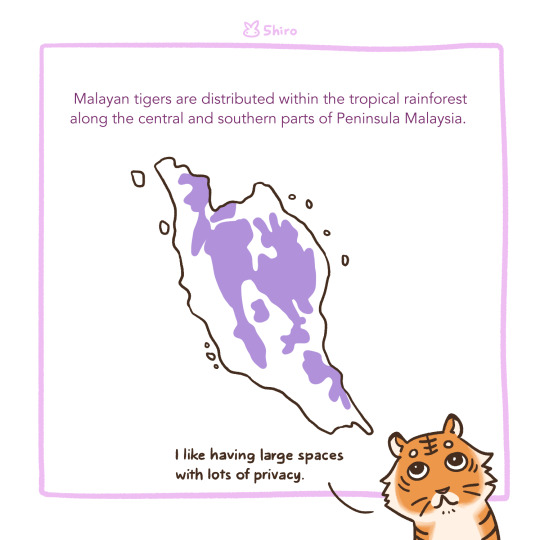
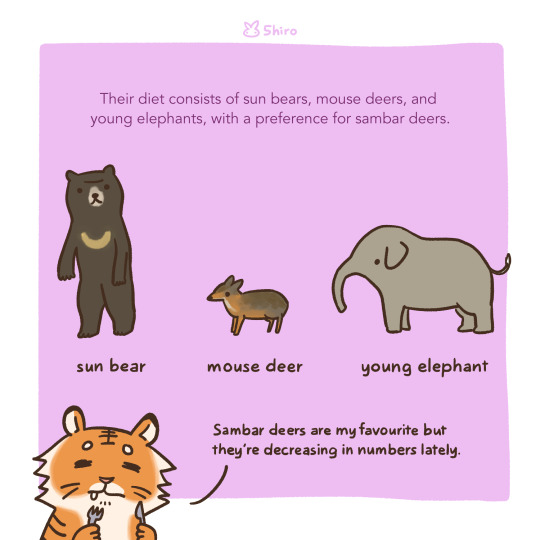

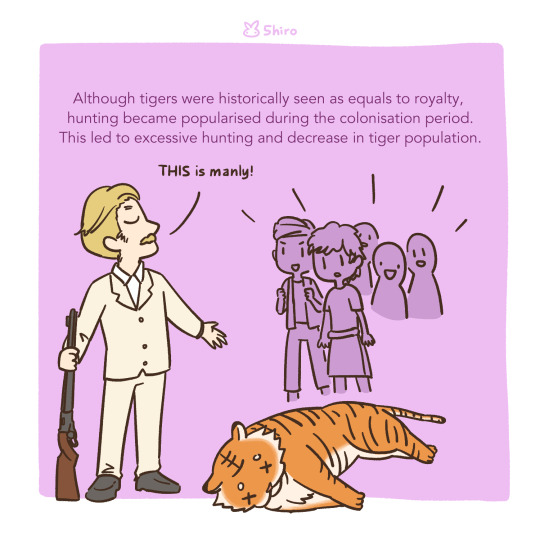


A Guide to Malayan Tiger
It was rather challenging to research this subspecies due to its recent identification, but I tried my best to gather some interesting facts!
#art#original#illustration#tiger#malayan tiger#panthera tigris jacksoni#malaysia#animal facts#illustration guide#fun facts#endangered animals
46 notes
·
View notes
Text
Close Brothers

Critically endangered Malayan Tiger siblings in the local zoo.
Photo credit: Jonathan Chua.
This pair appeared to be quite comfortable with this spot and didn't seem likely to move around soon. So I had to be content with capturing them where they were. In post, background foliage especially those around their heads were 'burned' so that the tigers could stand out better.
#animal pics#flora fauna#Malayan Tigers#nikon photography#nikon zfc#Panthera tigris jacksoni#photography editing#tamron 16-300mm#tiger photos#wildlife photography#photographers on tumblr
2 notes
·
View notes
Text
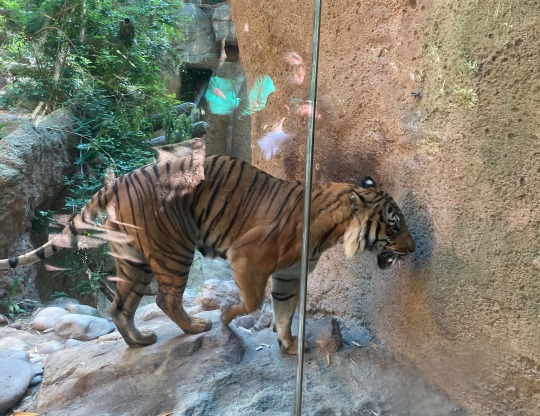


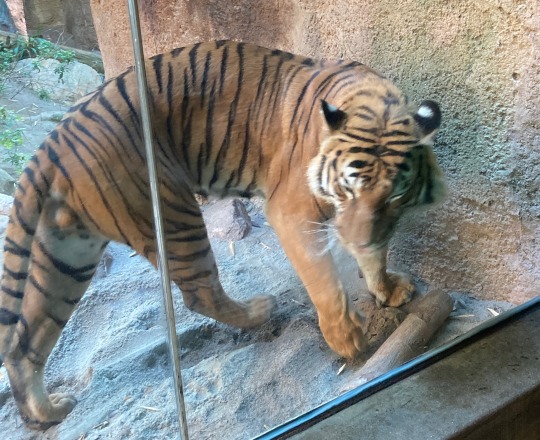






5 notes
·
View notes
Note
what’s a bengal tiger? 😅
Sooooo, I got a little bit out of control with this answer, because I love tigers so much, so I talked about all the tigers, whoops also if you want pictures I’ll gladly add them, just let me know ☺️
Bengal Tigers are sometimes known as Royal Indian Tiger or just Indian Tiger. They’re part of the subspecies of Tigers in the world. There’s many different types of tigers, some look very very similar but they’re named after where they’re mainly found the different types of tigers and I’ve also added how to tell the difference between them. They’re gorgeous creatures and I’m very passionate about their growing population and the rights to protect them. Because of their home being destroyed it’s known that some tigers come out and kill humans to survive resulting in them being poached. It’s truly sad, my zoo has two tigers are they’re part of a big effort to grow the tiger population back to where it used to be, I cry every time I see them because they’re just so gorgeous
• Bengal Tigers native to the Indian subcontinent. Although it once roamed a much larger area, the Bengal is currently found in India, Bangladesh, Nepal and Bhutan.The Bengal tiger is on the endangered list. It’s the most well-known breed of tiger and the largest tiger found in the wild. A male Bengal weighs between 397 and 569 pounds. The female is smaller, weighing between 220 and 350 pounds.
• White Tigers a genetic mutation more commonly found in captivity as they’d be easily hunted because they have no camouflage
• Siberian Tigers also known as the Manchurian tiger, Korean tiger, Amur tiger or Ussurian tiger, is an endangered species that lives in Northern Asia (China, Russia and Korea It’s said that even though the Bengal Tiger is the world’s largest tigers weighing up to almost 600 pounds. Crossbreeds such as the liger, a mix between a female tiger and a male lion, get much larger than their parents, however. A full-grown male liger can weigh as much as 1600 pounds! That’s three times the size of a Bengal or Siberian tiger. When Bengals and Siberians are crossbred, they also become larger than their parents.
• Sumatran Tigers are the smallest of the subspecies because it only lives on the Island Sumatran off the coast of Indonesia and are separate from their “mainland” cousins. The stripes of the Sumatran are very dark and well-defined. They cover the tiger’s entire body, including its forelegs. Not all tigers have stripes on their front legs.
• The Indochinese tiger (Panthera tigris corbetti), also known as Corbett’s tiger, is named in honor of the famous British hunter Jim Corbett who was often enlisted to hunt down man-eating tigers and leopards early in the 20th century. The near critically endangered Indochinese tiger is native to Southeast Asia (China, Thailand, Laos, Burma and Vietnam). The illegal trade of tiger parts which are in high demand is the main reason for a quickly dwindling Indochinese tiger population. There are only around 300-400 Indochinese tigers left in the world today. Tiger parts are used in rituals, for meat (internal organs), and to make jewelry, medicines, clothes and wines. Very little of the tiger remains unused. The Indochinese tiger has narrow, single stripes.
• The Malayan tiger (Panthera tigris jacksoni and occasionally Panthera tigris malayensis) is also known as the Southern Indochinese tiger. Its native range is Southeastern Asia (Burma, Thailand and Malaysia).The Malayan Tiger is very similar in appearance to the Indochinese tiger except that it’s slightly smaller. It wasn’t even considered a unique breed separate from the Indochinese tiger until the early 2000s. Malayan tiger numbers are shockingly low. There are less than 200 breeding adults in the world, and their numbers are still declining! The Malayan tiger has become critically endangered due to habitat loss and poaching. Like the Indochinese tiger, Malayan tiger parts are used in a variety of ways from cultural rituals to traditional medicines.
• The South China tiger (Panthera tigris amoyensis) is also known as the Chinese tiger, the Xiamen tiger and the Amoy tiger. It’s native to eastern and central China (the Jiangxi, Guangdong, Fukien and Hunan provinces); however, one has not been spotted in the wild for decades. The South China tiger is critically endangered and facing possible extinction. Only 30 to 40 are known to exist in the world, and all are living in captivity. When the Chinese government was clearing land for development, they had all tigers killed that were displaced. Habitat destruction and eradication measures led to the decimation of the South China tigers in the wild. Regretting their actions, the Chinese government now works to protect the South China tiger. Currently, zoos in China and South Africa have breeding programs working hard to increase their numbers.
It makes me horribly sad and upset to know that people and governments aren’t protecting a vital part of their ecosystems. If I wasn’t in nursing school I’d become a wildlife conservationists because I’m so passionate about it, honestly Steve Irwin is what got me so passionate about animals and I try to do everything I can for these gorgeous creatures. Sorry I geeked out a little bit
8 notes
·
View notes
Text
tiger names
amur
altaica
bengal
bali
balica
caspian
corbetti
cub
jacksoni
javan
panthera
tigress / tigris
tigra
tigger
tiger / tigre
tiikeri
tígri
tygrys
tigru
tigr
whelp
#tiger#tigers#tiger names#list of tigers#name lists#name suggestions#name ideas#read dni#name blog#name request#read my dni#name inspiration#baby names#gender neutral names#fleur speaks
12 notes
·
View notes
Photo

The Malayan tiger is running out of time.
The critically endangered Malayan tiger faces tremendous pressure from the illegal wildlife trade, habitat loss, logging, and other human pressures. Poaching in particular is driving their rapid decline, pushing them quickly towards extinction.
Join me and my granddaughters on a mission to Save the Tigers from imminent extinction.
You can help us save them by going to https://endangeredtigers.org/ and purchase our tiger themed digital product bundle.
Proceeds benefit tiger conservation / endangered tigers.

#Malayan tiger#tigers#tigers extinction#panthera tigris jacksoni#save tigers#Critically Endangered#endangered animals#endangered tigers#tiger conservation
1 note
·
View note
Video
Jungle Cat by Helene Hoffman
Via Flickr:
Malayan tiger called "Cinta" enjoying a dip and drink in his pool. Cinta was born January 2014 at the Fresno Chaffee Zoo and now lives in Tiger River at the San Diego Zoo. Conservation Status: Critically Endangered
#Malayan#Panthera tigris jacksoni#wildlife#Conservation status: Critically Endangered#tiger#big cat#Tiger River#San Diego Zoo#Cat#mammal#carnivore#animal
0 notes
Text

Malayan Tiger
Panthera tigris jacksoni
Source: Here
#malayan tiger#tiger#tigers#feline#felines#cat#cats#big cat#big cats#big#animal#animals#wildlife#nature
156 notes
·
View notes
Photo

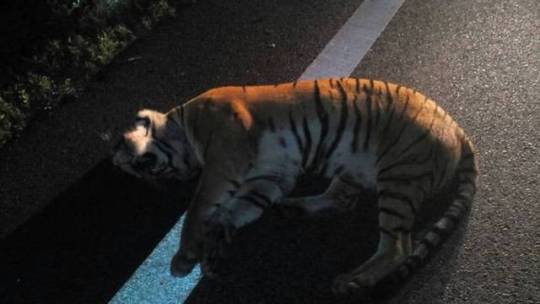

Roadkill of an adult female Tapir
Roadkill of a female Tiger
Roadkill of a baby Elephant
Photos: Perhilitan
Malaysia: Malaysia to roll out wildlife crossing awareness measures after spate of roadkill cases
By Sumisha Naidu, 21st October 2017;
Malaysia is planning to build more viaducts and roll out wildlife crossing awareness at driving schools after recording more than 2,000 roadkill cases on the peninsula over five years, many involving endangered animals.
Between 2012 to 2016, wildlife roadkills have included not only the more common Monitor Lizards (Varanus spp.) (667 cases) and Macaques (Macaca spp.) (393) but also endangered animals such as Malayan Tapirs (Tapirus indicus) (43), according to the Ministry of Natural Resources and Environment in a statement this week.
In the first nine months of 2017, the Malayan Tapir topped the list of endangered animals killed on the road, followed by Asian Leopard Cats (Prionailurus bengalensis) (14), Elephants (Elephas maximus) (2), Binturong or Asian Bearcats (Arctictis binturong) (2) and one Leopard (Panthera pardus).
Johor recorded the highest number of incidents in the past five years with 494 such cases, followed by Kedah (479), Perak (394), Terengganu (310) and Negeri Sembilan (161).
"This totally senseless killing of our animals has to stop and is such a waste of our national heritage," said minister Wan Junaidi Tuanku Jaafar in a statement on Monday (Oct 16).
According to officials, wildlife roadkill incidents usually occur at night, when the animal is trying to cross a road or highway from one area of forest to another in search of food, mates "or seeking more suitable habitat for its survival".
In August, a pair of Tapirs were killed by a motorist at the Gebeng bypass, days after an Elephant died when a tour bus ran into it in Perak.
Last year, a critically endangered Malayan Tiger (Panthera tigris jacksoni) which was pregnant with two cubs was run over by a car headed to Kuala Terengganu.
HELPING ANIMALS GET TO THE OTHER SIDE
Malaysia's Department of Wildlife and National Parks (PERHILITAN) has so far installed 236 warning signs at 133 roadkill hotspots to warn drivers to slowdown.
"Please slow down when you see these warning signs," said Dr Wan Junaidi.
"It is indeed disheartening to know that some drivers tend to speed up when they see those animal crossing signs."
Dr Pazil Abdul Patah, the director of the Department of Biodiversity Conservation at PERHILITAN told Channel NewsAsia that his department is in talks with driving schools across the country to incorporate wildlife crossing awareness into their curriculums by next year.
Three viaducts have also been built specifically to help wildlife cross safely, with plans for more.
"It has been positive to see a lot of wildlife have been using the viaducts - Elephants, Sun Bears (Helarctos malayanus), Tapirs, Deers (F. Cervidae), Wild Boars (Sus scrofa) and smaller animals like Civet Cats (F. Viverridae) and Flat-headed Cats (Prionailurus planiceps)," said Dr Pazil.
Dr Wan Junaidi told Channel NewsAsia most road builders have been told to create wildlife-friendly viaducts when building through forests and sanctuaries as well.
However, environmentalists are concerned that roadkill incidents will only increase with several major rail projects in the works - including the High-Speed Rail linking up Singapore to Malaysia and the East Coast Rail Link cutting across the Titiwangsa mountain range.
Dr Junaidi said that his officers are providing input on these projects for developers to include tunnels and viaducts for wildlife in their construction plans.
Source: Channel NewsAsia
#Malaysia#roadkill#threats#human activities#Peninsular Malaysia#West Malaysia#Channel NewsAsia#mammals#Malayan tapir#Tapirus indicus#Asian tapir#Asian elephant#Indian elephant#Elephas maximus#Elephas maximus indicus#Malayan tiger#tiger#Panthera tigris#Panthera tigris jacksoni#leopard cat#Asian leopard cat#Prionailurus bengalensis#binturong#Arctictis binturong#leopard#Indochinese leopard#Panthera pardus#Panthera pardus delacouri
0 notes
Photo

Malayan Tiger
#NY#NYC#New York#New York City#Bronx#zoo#Bronx Zoo#tirger#Panthera#Malayan Tiger#Panthera tigris jacksoni
0 notes
Text
Common Interest

Malayan Tigers checking out their lunch in the local zoo. Photo credit: Jonathan Chua.
#photographers on tumblr#animal pics#flora fauna#malayan tiger photos#Panthera tigris jacksoni#pentax 18-270mm#pentax kr#pentax photography#wildlife photography
0 notes
Text
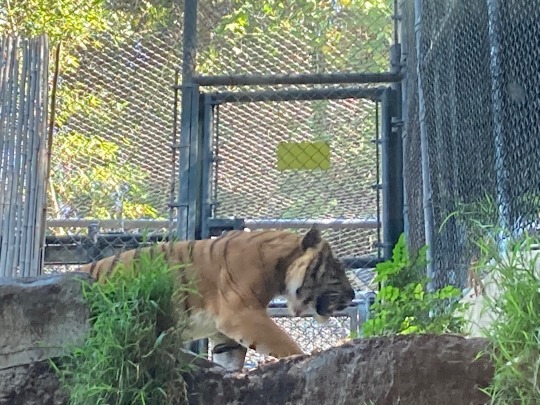
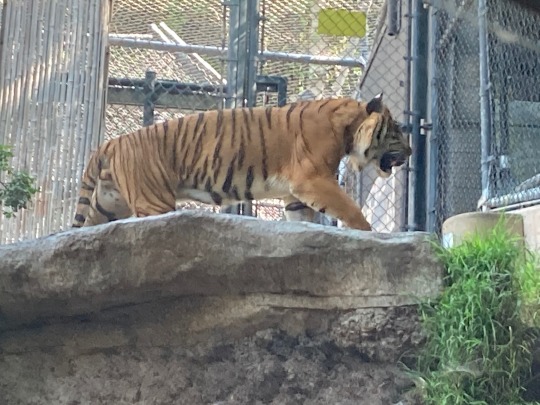

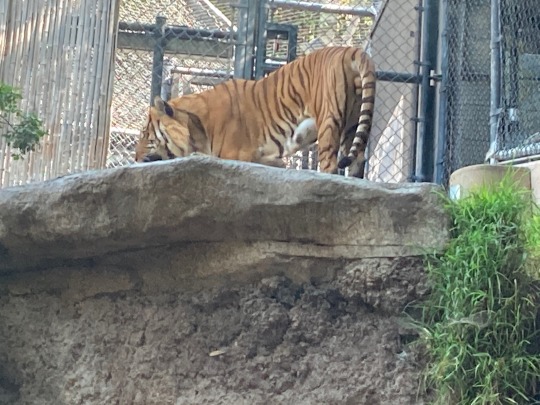

4 notes
·
View notes
Photo
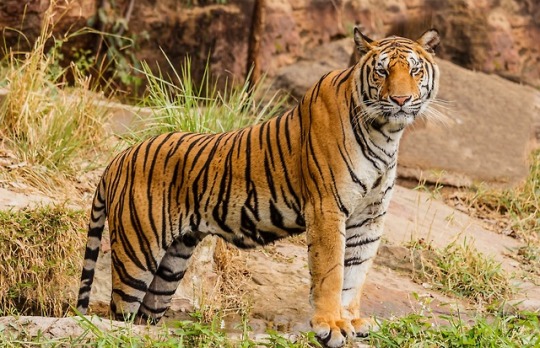

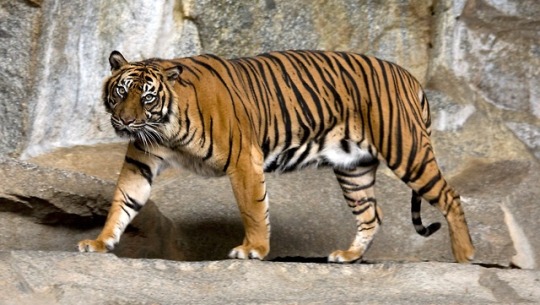

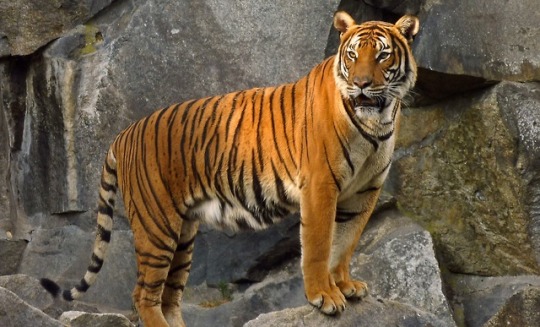

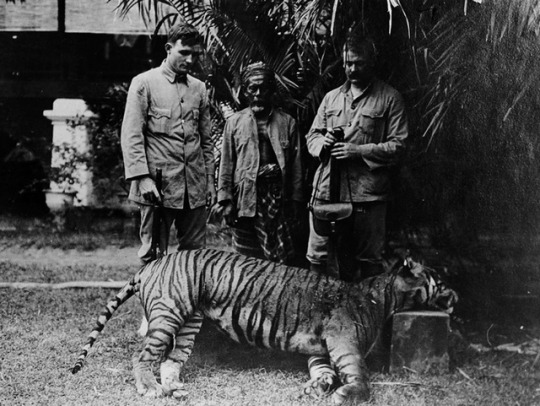


Endangered Felines, part 1
Tiger, Panthera tigris
Without a doubt one of the most iconic and recognizable animals on Earth, the tiger was voted the world’s favorite animal in 2004, with the domestic dog coming in second, and dolphins third.
I was planning on splitting tigers into one post per subspecies, but since there are sadly so many cat species that are endangered, this series will be long enough already, and it gives a better overview to have them all in one post.
And just as I was researching for this post, it turns out that in 2017, the tiger was reduced to a mere two subspecies - the mainland (P. t. tigris), and the Sunda Island (P. t. sondaica) populations - but this is disputed, as there are morphological and genetic differences between these populations. In this post, I will treat them all as their own subspecies.
While at first I was a bit skeptical about the switch to now only having two tiger subspecies when I think about it more, it's actually great for tiger conservation, because that means we don't have to be "subspecies purists" anymore. This means we can repopulate areas with another population easier, without claims of "it's an invasive/foreign animal".
While I will try to keep each topic brief, this will still be a lengthy and exhaustive post, as you can’t simply brush over things in the most beloved and famous endangered animal on Earth.

This is the historic range of all tigers. From the far northeast of Russia to the east of the Black Sea, by Georgia, Armenia and Azerbaijan, all the way to the far southern islands of Java and Bali.
Today, they have been extirpated from most of their range, with three of the nine former subspecies extinct. By 2017, there were just under 4000 tigers in the wild combined, and that is after a recent rise in numbers, for the first time in over a century. A couple of hundred years ago, there were at least 40 000 tigers in India alone.
They are estimated globally to have numbered around 100 000 in the year 1900, meaning 97% of tigers were lost in a century.
Occasionally hunted throughout history, either because of fear, sport among the wealthy or for their parts, tiger hunts took on a new dimension when Europeans colonized India and other parts of South Asia, with "gentlemen sports hunters" proudly subduing nature. And later in the 20th and 21st centuries, mainly poaching for body parts used in "traditional medicine".
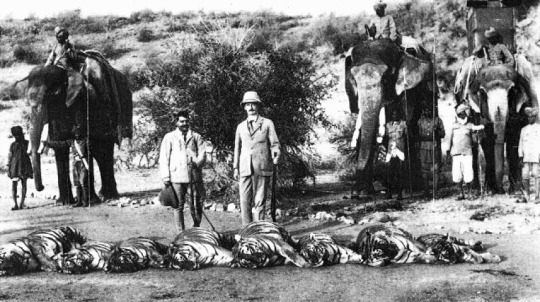
An Indian tiger hunt carried out by Lord Reding, Viceroy of India, likely in the mid-1920s.
Direct hunting is not the only threat against tigers, as the human population in Southeast Asia has exploded over the past century, and today, there is nowhere left for wildlife to go.
The tiger has been listed as endangered under the IUCN, consistently since its first assessment in 1986.
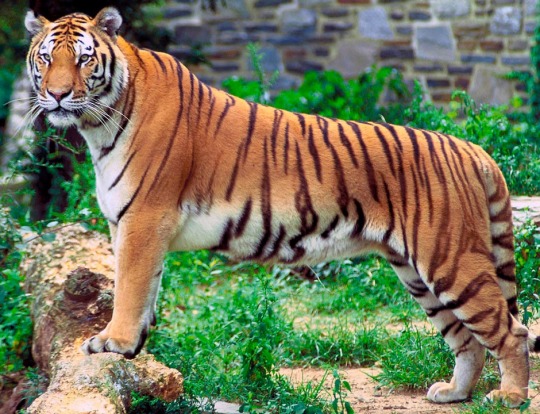
Bengal tiger, Panthera tigris tigris
The Bengal is without a doubt the most well-known of all tiger subspecies, not the least due to our strong association of tigers with Indian culture. They are also the most numerous tiger population today.
They are 90-110 cm tall at the shoulders and weigh up to 325 kg, with males averaging 235 kg, and females ranging from 116-164 kg.
Given a separate assessment by the IUCN in 2008, the Bengal tiger is considered endangered. Today, they number around 2300 animals in the wild, 1700 of which are in India, 440 in Bangladesh, 200 in Nepal, and 75-100 in Bhutan.
The population is severely fragmented, and no subpopulation contains more than 250 animals. Despite cautiously optimistic news a couple of years ago, they are still considered "decreasing".
If 40 000 was the original number of tigers in India, today, there are only 4% left, and it is still the biggest stronghold of wild tigers anywhere.
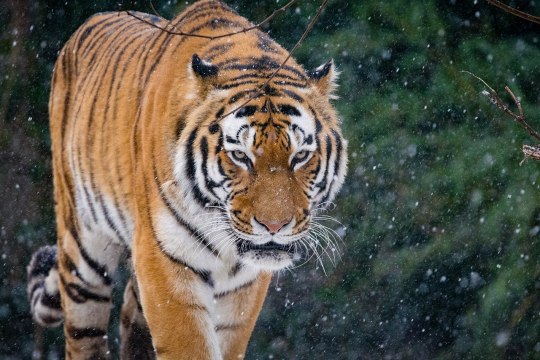
Amur tiger, P. t. altaica
More famously known as Siberian tiger, this name is inaccurate as they don't live anywhere near Siberia, which is a large chunk of eastern Russia, having no eastern coastline. While the tiger lives in the very far southeast, near Korea. They are also known as the Manchurian, Ussurian and Korean tiger.
As can be seen on the map above however, they did have a far larger range before widespread hunting nearly wiped them out.
The largest cat on Earth today (after the extinction of the Caspian tiger), they are the second most numerous tiger population, at around 500 animals in the wild (in 2005, they were estimated at 360). They were saved on the brink of extinction, as only a couple of dozen animals remained when they were finally protected.
Despite this vast increase however, the effective population size is only equivalent to around 30 animals, which is close to the total world population when they were saved from extinction. This is due to inbreeding from a smaller and smaller population that then had only a handful of already related animals to rebound from.
It was in the early 20th century that the Amur tiger was nearly wiped out, due to the massive societal change that was going on in Russia at the time. Armies on both sides of the civil war based in Vladivostok made it their mission to kill as many tigers as they could.
Tigers were extirpated from the Korean peninsula by the Japanese in the same period, when Japan occupied Korea. Today, South Korea is working on once again creating a home for the Amur tiger in their lands.
The Soviet Union finally banned tiger hunting in 1947, after which anti-poaching control was very strict. Cubs kept being live-caught well into the 1960s however.
In the middle of the 1900s, deer populations fell in the Amur tiger's range, leaving them no choice but to find other prey. Bizarrely, more than 30 cases of tigers attacking bears were recorded, and bear hair was found in tiger droppings.
After the fall of the Soviet Union in 1991 and the subsequent economic and societal collapse, people were free to poach tigers again, with some doing it to sell to the Chinese market. Today however, the population is stable, but vulnerable.
In 1965, it was given the listing of "status inadequately known", and this was not changed until 1996, when they were assessed as "critically endangered". This laster until 2008, when they were moved to endangered.
At present, there are about as many Amur tigers in human care as there are in the wild, totalling about 1000 Amur tigers on the planet. The zoological population has a higher genetic diversity than wild tigers, as the foundation stock was largely caught when tigers were more numerous in the wild.

Sumatran tiger, P. t. sumatrae
The Sumatran is the one tiger that I personally can recognize easily, due to their striking and bold facial pattern. They are among the smallest tigers alive today, with males reaching only 140 kg - this is a size similar to jaguars. They are also the only Indonesian or Sunda island tiger still in existence.
The Sumatran tiger has been consistently listed as critically endangered since their first assessment in 1996.
They number approximately 500-600 animals, not including ones in zoos and other collections.
Their threats are mainly a shrinking habitat due to palm oil and Acacia plantations leading to a depletion of prey, as well as poaching for their body parts.
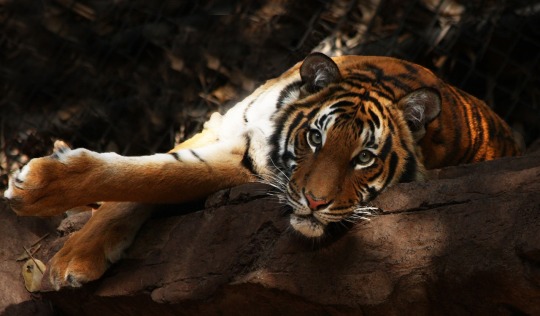
Malayan tiger, P. t. jacksoni
Although recent research has discovered that there is no real difference between this and the Indochinese tiger, it was considered its own subspecies since a DNA analysis in 2004, until the recent merge where all mainland tigers are considered P. t. tigris.
Subspecies or subpopulation, the Malayan tiger was listed as “endangered” in 2008, and in 2014, it was reassessed under its current listing as critically endangered.
This was because they had declined by 25% in only one generation (7 years).
In the 1950s, there were about 3000 Malayan tigers. In the 1990s, there were 500, and in 2013, they were estimated at 250-340 animals. This gives an estimate of only around 100 breeding adults in the wild.
The total number in human care is difficult to get to, but apparently in 2011, there were 54 Malayan tigers in American zoos alone, spread across 25 facilities.
The Malayan tiger's habitat has shrunk from nearly 100 000 square kilometers before 1970s, to less than 45 000 square kilometers in 2014. Aside from this threat, is of course poaching for body parts for a Chinese market. Between the years 2000-2013, body parts equating to 1425 tigers had been seized, 94 of these being Malayan tigers.
The Global Tiger Recovery Program, made up of 13 countries where tigers live, set a goal in 2010 to double their tiger populations by 2022. Malaysia had made a similar promise before this agreement, in 2009, with their National Tiger Conservation Action Plan setting to doubling Malaysia's tiger population by 2020.
With the new population estimate of 250-340 adult Tigers and diminishing prey base and natural forests, it is biologically impossible to reach the NTCAP target by 2020.
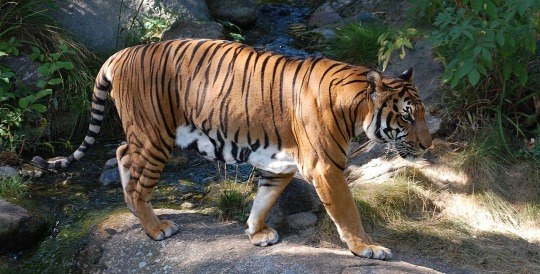
Indochinese tiger, P. t. corbetti
The Indochinese tiger lives in Southeast Asia, and is viewed as the ancestor of all tigers, the other subspecies diverging around 72 000-108 000 years ago.
They are functionally extinct in Vietnam, Cambodia and possibly China, and number around 300-400 animals in total, the largest population being in Thailand.
They have been listed as endangered since 2008.
They are the least represented in zoos out of all tiger subspecies, and no coordinated breeding program exists. Approximately 14 zoo tigers have been discovered to be Indochinese after DNA analysis of 105 animals in 14 countries.
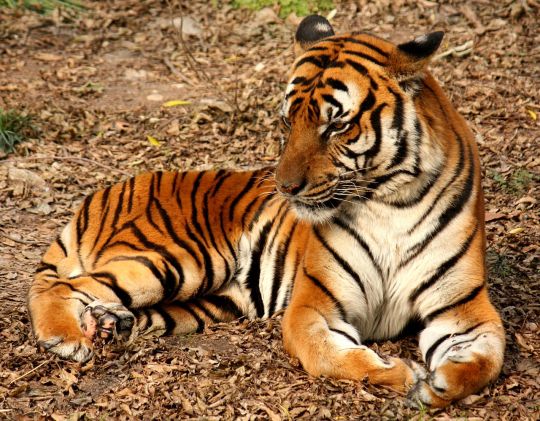
South China tiger, P. t. amoyensis
This is the most threatened tiger subspecies as they are believed to be extinct in the wild, since the last time one was live-caught in the 1970s.
Only 20 years earlier, they numbered more than 4000 animals, but then came Mao Zedong's "Great Leap Forward", when all wildlife stood in the way of "progress" (remember the Baiji).
Large-scale government anti-pest campaigns took off, and tigers were massacred, mercilessly. This was made worse by deforestation, heavy settling of the countryside from the cities (as part of the GLF) and over-hunting of their prey.
By 1973, they were partially protected, and by 1977, hunting was completely prohibited.
By the early 1980s, they were estimated at 150-200 animals, though not one tiger has been seen since the early 70s.
They are considered critically endangered, possibly extinct in the wild, but there is hope there still are a handful of tigers holding on in the wilds of China. For example, in 2007, a bear and a cow were killed by what was most likely a tiger.
In 2005, the entire zoological population numbered 57 animals descended from only six tigers. Despite being inbred and suffering poor breeding success as a result, DNA tests showed many aren’t pure South China tigers anyway. Another estimate (made difficult by crossbreeding) in 2007 put the global zoological population at 72 animals.

Bali tiger, P. t. balica
The Bali tiger, formerly inhabiting only the island of Bali since 12 000 - 13 000 years back, was the smallest of all tigers, with males only reaching up to 100 kg and females 80 kg, putting this tiger around the same size as a jaguar or cougar.
They were only listed as extinct by the IUCN as late as 2008, but the last one probably died just after the second world war, with the last known tigers recorded in the 1930s.
The Bali tiger was killed off through a lethal cocktail of environmental destruction (palm plantations and rice fields) and sports hunting by the Dutch colonizers. The West Bali National Park was established in 1941, but it came too late to save the tiger.
This animal was never filmed alive nor held in zoos (though it seems the Ringling Bros Circus had one), and it is very difficult to even find photos of live animals.

Javan tiger, P. t. sondaica
The Javan tiger was small, but just larger than the Bali, and similar in size to the still living Sumatran. They were notable in appearance by often having very sparse stripes around the front legs and shoulders.
This population was pronounced extinct by the IUCN in 2003, but the last confirmed sighting was recorded as far back as 1976. Several accounts of alleged sightings exist however, even within the last ten years, including a person supposedly being killed by a tiger in 2008.
In 2017, a blurry image surfaced of what was supposedly a Javan tiger. It was however most likely a Javan leopard, also a critically endangered cat.
We can always hope at least some of these alleged sightings were of tigers, but there is always the possibility that the animals witnessed were actually leopards.
At the turn of the last century, 28 million people lived on Java, while today, it is a jaw-dropping 145 million (resulting in a mind-blowing population density of 1.121 people per square kilometer - in comparison, the state of New York has a population denity of 416 people per square kilometer).
By the middle of the 1800s, people considered tigers a plague, and by the turn of the century, 150% more land had to be cleared for agriculture in only 15 years. By 1975, only 8% of the island's forests remained.
These tigers were poisoned, hunted, their main prey nearly died out, and the forests were cleared for lumber and agriculture.
To make things even worse, World War 2 happened, so the few that were kept in zoos were lost. After the war, it was easier to obtain Sumatran tigers, so none were taken from Java.
A funny thing to note is how the Javan people’s fear of the tiger led them to always referring to it as “Mr. Tiger”. They thought that if they spoke of it in a casual way, the tiger might hear them and take revenge.
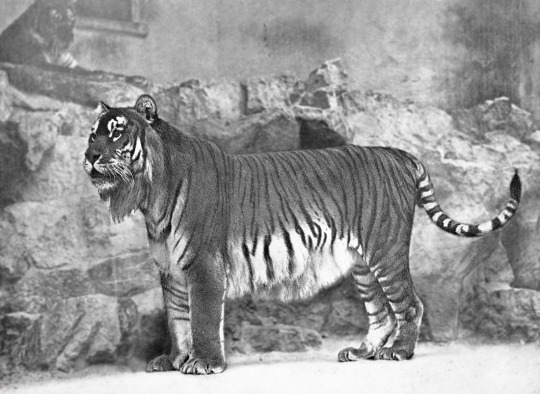
Caspian tiger, P. t. virgata
Like the Javan tiger, the Caspian was pronounced extinct by the IUCN in 2003, but the last record was in the early 1970s, and it died out some time during this decade.
It was possibly the largest cat in the world during recorded human history, after the ice age extinction of the cave lion.
It lived across parts of Georgia, Armenia and Azerbaijan, eastern Turkey, northern Iran, parts of Uzbekistan, Afghanistan, Turkmenistan, Kazakhstan, Kyrgyzstan, Tajikistan, even well into western China.
The last tiger in Georgia was shot in 1922, they were last recorded in Kazakhstan in 1948, one of the last in Iran was shot in 1953, the last in Turkmenistan was killed in 1954.
Tigers were killed both for sport and as pest control, including by the Soviet army. Up until World War 1, about a hundred tigers were killed in a forest area of the Afghanistan-Tajikistan border - every year. To make matters worse, their natural prey (pigs) declined heavily in the early 1900s due to overhunting and disease, and agriculture destroyed much of the tiger's natural habitat.
While this unique population is gone forever, there are plans to perhaps one day restock the area with Amur tigers, the closest living analogue to the Caspian tiger.
In a day when habitats are shrinking, other habitats may open up, and this could give the Amur tiger a greater hope to continue into the future.
The “there are more tigers in people’s backyards / basements than in the wild”-myth
More of a misrepresentation than a myth, it is true that there are more tigers in human care across the globe than there are in the wild. This is nothing strange for such an endangered animal.
The Scimitar-horned oryx, for example, was up until a couple of years ago extinct in the wild. There are now a few dozen roaming completely wild, while there are up to 11 000 of the antelopes in Texas alone.
The Eastern Bongo numbers around 400 animals in American collections alone, four times the population remaining in the wild!
The Przewalski's horse numbers around 2000 animals, and although many live in free-ranging reserves, only around 400 are considered truly wild and living in their native habitat, after reintroduction programs.
The Père David’s deer was extinct in the wild until some animals escaped and formed a population now some 700 strong, but it's still far outnumbered by the zoological population.
The blue-throated macaw numbers only around 300 animals in the wild, and the World Parrot Trust previously said there were "up to a thousand" in cages.
The Spix’s macaw numbers around 130 birds in human care, and was considered extinct in the wild since the last known bird disappeared in 2000, until one was discovered in 2016. If there are more in the wild, it is only a handful of scattered individuals.
The Hawaiian crow is extinct in the wild since 2002, with just over 100 birds in human care.
The Socorro dove has been extinct in the wild since 1972, with 150 birds alive today, all in cages.
The Guam rail is extinct in the wild since 1987, with some 160 birds alive in zoological facilities.
The orange-bellied parrot numbers around 340 in human care, with less than 20 in the wild.
It is however not true that there are more tigers in America than in the wild, let alone "in people's basements".
That claim is completely absurd, and while sometimes tigers are abused and neglected as with all animal species, that is extremely rare and would be far more common in their native Asia than in America.
According to the Feline Conservation Federation, the United States held just under 2900 tigers in 2011. In contrast, a decade ago in China, there were over 4000 tigers in human care in that country alone. The IUCN states (unknown date) that there are some 6000 tigers in China, mainly farmed for body parts.
We can debate the ethics of these various tiger facilities, but a large number also live in zoos and conservation centers. There is no such thing as several thousand "pet tigers" living in people's living rooms, backyards, or basements.

Privately owned tigers in America, courtesy of the Feline Conservation Federation.
But what the popular media likes to do, other than misrepresent the numbers (and say there are "10 000 pet tigers in American backyards" or some such nonsense), they also like to say that it's this vast number in human care ("captivity") that is the problem!
When people hear for example that there are 3000 tigers in the wild and 5000 or something in America, they seem to think America "stole" those tigers from the wild, and they must be put back! While in reality, tigers in the west have spent decades and generations on the continent, in zoos, circuses, and private collections.
And if you could take America's 2900 tigers and release them all, say hypothetically that it was allowed (many are not "pure") and that they could all survive in the wild. The threats on tigers in the wild, from poaching and habitat destruction, is still nowhere near gone.
So then we could have 5900 tigers for a while, and then a decade or two later, we'd be right back at 3000 again, with NOT ONE tiger alive in American breeding programs. Now who would that help?
That there are more tigers in human care than in the wild is a tragedy of the wild, not of "captivity".
In conclusion
Tigers are the most beloved endangered animal on the planet, and given both their popularity as well as their comparatively vast numbers in human care, the species stands a good chance at surviving indefinitely.
Whether that will only be in zoos, farms and other collections for the foreseeable future, or whether our children and grandchildren will have a chance to see tigers roaming freely in their natural habitats, free from persecution, is another question.
http://www.iucnredlist.org/details/15955/0
https://wildfact.com/forum/topic-on-the-edge-of-extinction-a-the-tiger-panthera-tigris?page=17
https://www.theguardian.com/uk/2004/dec/06/davidward
http://www.prweb.com/releases/2011/9/prweb8805806.htm
http://www.prweb.com/releases/2011/9/prweb8840075.htm
https://blog.nationalgeographic.org/2015/02/21/is-extinct-forever-central-asias-caspian-tiger-traverses-the-comeback-trail/
https://www.inverse.com/article/26481-caspian-tigers-extinct-central-asia-amur-kazakstan
https://asiancorrespondent.com/2018/04/south-korea-to-open-asias-largest-tiger-forest/
#Endangered Felines#tiger#Bengal tiger#Amur tiger#Siberian tiger#Sumatran tiger#Malayan tiger#Indochinese tiger#South China tiger#Bali tiger#Javan tiger#Caspian tiger#extinct animals#poaching#deforestation#Big Cat Rescue#BCR#pet tigers#pet tiger#exotic pets#Feline Conservation Federation
30 notes
·
View notes
Text
Top 9 subspecii de tigru de pe Terra. Trei dintre ele au dispărut deja
Evoluția a făcut că oamenii să fie contemporani cu nouă specii de tigri, unele dintre acestea au dispărut în decursul ultimului secol.
Tigrii sunt unele dintre cele mai cunoscute feline la nivel global, culorile acestora captând imaginația scriitorilor, dar și a fotografilor de-a lungul timpului.
Din punct de vedere științific, tigrii sunt o specie de mamifere carnivore din familia felinelor, dar și una dintre cele patru specii ale genului Panthera. Oamenii de știință explică faptul că aceste feline sunt unele dintre cei mai mari prădători tereștri, culorile lor fiind adaptate mediului în care au evoluat.
Studiile și observațiile oamenilor de știință au dus la concluzia că tigrii pot fi împărțiți în nouă subspecii, acestea diferențiindu-se prin modul în care sunt dispuse dungile lor. În prezent mai spravieșuit doar șase subspecii, celelalte trei dispărând odată cu scăderea populației generale de tigri. Live Science a creat o listă cu aceste subspecii.
9. Tigrul de Sumatra
Numele științifici al acestei subspecii aceste acela de Panthera tigris sumatrae și după cum sugerează acești tigri pot fi întâlniți pe insula Sumatra. Aceasta este singura subspecie de tigru care a reușit să supraviețuiască în regiune, celelalte două fiind dispărute de câteva decenii.
Analizele genetice indică faptul că aceștia au un ADN diferit față de cel al speciilor de pe continentul asiatic. Tigrul de Sumatra persistă în populații mici și fragmentate de-a lungul insulei, în pădurea de la nivelul mării aflată pe coasta joasă a Parcului Național Bukit Barisan Selatan, în zona de sud-est a provinciei Lampung sau în pădurile de munte ale Parcului Național Gunung Leuser.
8. Tigrul siberian
Panthera tigris tigris, este cea mai mare subspecie de tigru și își are habitatul în Siberia, nord-estul Chinei și după cum speculează unii cercetători, chiar și în Coreea de Nord.
Masculii pot atinge până la 3,3 m de la cap până la coadă și cântăresc până la 300 de kilograme. Femelele sunt mai mici, atingând doar 2,6 m în lungime și aproximativ 100 până la 167 kilograme în greutate.
7. Tigrul indian
Această subspecie mai este numită și tigrul de Bengal și după cum sugerează numele populează subcontinentul indian. Unele ONG-uri estimează că în India trăiesc până în 4.000 de indivizi ai aceste subspecii.
În timp ce majoritatea tigrilor de Bengal au o colorație obișnuită pentru specia lor, o genă recesivă face ca unii să fie crem sau chiar de culoare albă în loc de portocaliu.
6. Tigrul din sudul Chinei
Panthera tigris amoyensis sunt specifici zonei de sud a Chinei și după cum explică specialiștii aceștia reprezintă o subspecie critic periclitată. Estimările sugerează existența a doar cîteva zeci de astfel de tigri în grădinile zoologice și în sălbăticie.
În urmă cu doar cinci decenii populația acestei subspecii număra cîteva mii de exemplare, dar deoarece au fost declarați dăunători, vânătorii au putut să reducă dramatic efectivele acestora.
5. Tigrul malaezian
Cercetătorii numesc această subspecie Panthera tigris jacksoni, iar identificarea acesteia a avut recent, în anul 2004. Acest tigru poate fi întâlnit în pădurile tropicale și subtropicale foioase din vârful sudic al Thailandei și Malaeziei peninsulare.
Această subspecie fost numită pentru a-l omagia pe Peter Jackson, jurnalist și conservaționist britanic, implicat activ în eforturile de salvare a tigrilor.
4. Tigrul indo-chinez
Panthera tigris corbetti sau tigrul indo-chinez este numit după vânătorul și jurnalistul britanic Jim Corbett și își are arealul în Cambodia, Laos, Burma, Thailand, și Vietnam. În urmă cu câteva decenii acest tigru putea fi identificat și pe teritoriul Chinei.
3. Tigrul de Bali
Una dintre cele trei subspecii de tigru dispărute, tigrul de Bali ultimele exemplare murind anii 1940, potrivit ONG-ului Salvați Tigrii. Această specie a fost numită de către cercetători Panthera tigris balica, iar extincția acesteia poate fi pusă pe seama mai multor cauze, printre care se numără vânătoarea, reducerea habitatelor și a prăzilor.
2. Tigrul de Java
Panthera tigris sondaica a dispărut în urmă cu patru decenii, ultimele exemplare murind în captivitate, în parcul național Meru Betiri în anul 1976. Totuși, dispariția acestora din sălbăticie a fost mai timpurie, în jurul anului 1940.
1. Tigrul caspic
Această specie de tigru a dispărut din salbaticie în jurul anilor 1970 din cauza reducerii habitatelor și a surselor de hrană.
Panthera tigris virgata a trăit din estul Turciei, nordul Iranului, Mesopotamia, Caucaz în jurul Mării Caspice, prin Asia Centrală până la nordul Afganistanului și al deșertului Xinjiang, aflat în vestul Chinei.
Citește și:
Imagini nemaivăzute de 85 de ani cu enigmaticul tigru tasmanian. VIDEO
Puiul de tigru ”Covid”, raza de speranţă de la o grădină zoologică din Mexic
China va permite din nou comercializarea produselor din oase de tigru şi coarne de rinocer
Modul de gândire al unui tigru şi principiile lui de viaţă vă pot ajuta să începeţi o săptămână corect
Articolul Top 9 subspecii de tigru de pe Terra. Trei dintre ele au dispărut deja apare prima dată în Descopera.ro.
0 notes
Photo

___250___🚨Critically Endangered: Malayan Tiger aka Panthera Tigris Jacksoni. 🐾🐾🐾🐾🐾🐾🐾🐾🐾🐾🐾🐾🐾🐾🐾🐾 Malayan tigers were classified as Indochinese tigers until DNA testing in 2004 showed them to be a separate subspecies. Their Latin name—Panthera tigris jacksoni—honors Peter Jackson, the famous tiger conservationist. Malayan tigers are found only on the Malay Peninsula and in the southern tip of Thailand. 🌎🌍🌏 #ThreadTheWord. @threadtheword.uk https://www.instagram.com/p/Bx2bSKnBLAs/?igshid=1lk7g6e7t5ecu
0 notes

